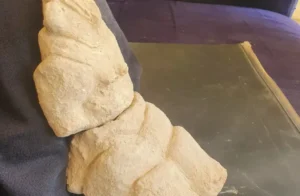The 20-centimeter figurine was found broken in two pieces next to the wall of a home at the Sha’ar HaGolan Yarmukian archaeological site.

Before the Israelis and the Palestinians, before the Greek and the Roman empires, before the Kingdom of Israel and the Kingdom of Judah, before the Umayyad Caliphate and the Crusader Kingdom of Jerusalem – there were the Yarmukians.
This 8,000-year-old Neolithic agricultural culture is considered the first culture in the prehistoric area of what today is called Israel. It is one of the oldest cultures in the Levant to make use of ceramic pottery, with a distinctive style of herringbone decorations incised in horizontal and diagonal lines over the body of their ceramic cooking, serving and storage vessels.
The culture is also known for its enigmatic and iconic “Mother Goddess” figurines, which are believed to have been part of a Yarmukian fertility cult.
Renewed excavations at the Sha’ar Hagolan Yarmukian archaeological site at the Sha’ar Hagolan kibbutz this month have revealed an unusually large and impressive ceramic goddess figurine of the “Mother Goddess.”
Created in the typical seating pose, the 20-centimeter figurine was found broken in two pieces next to the wall of a home, said excavation co-director Anna Eirikh-Rose, Israeli Antiquity Authority Judea district archaeologist, who is doing her doctoral research at the Hebrew University on Neolithic pottery.
The broken figurine was covered by a bracelet with a red bottom, the color which represented fertility. A schematic stone with etched eyes and mouth was also uncovered.
The excavation is being carried out in conjunction with the French Center for Research in Jerusalem under the co-direction of Dr. Julien Vieugue.
“This woman ceramic figurine is a hallmark of Yarmukian culture,” Eirikh-Rose said. “This is one of the largest examples of the figurine found. It is of a large, seated woman with big hips, a unique pointed hat and what is known as ‘coffee-bean’ eyes and a big nose. One hand is positioned on her hip and the other one under her breast.”
Symbolism
Though dubbed “coffee-bean” eyes, the traditional eyes of the figurine more likely represented kernels possibly of wheat, or more likely barley, she said.
All the small details of the figurine are important for its cultic symbolism, she said, and the process of creating such a figurine involved a complex method of wrapping and layering the clay around a central cylindrical core.
“It is really impressive, and was a very elaborate way of making a figurine,” she said. “It was not simple to make.”
The Yarmukian culture was poised at the dramatic human juncture of the transition from a foraging culture to a permanent settlement, which also changed the development of architecture. It was so named for the discovery of the archaeological remains at the Sha’ar Hagolan site dated to 6,400-6,000 BCE near the northern bank of the Yarmuk River in the central Jordan Valley.
The history of the Sha’ar HaGolan site
First excavated in 1949, the Sha’ar Hagolan site was identified by Hebrew University Professor Moshe Stekelis as belonging to the Yarmuk culture. A subsequent excavation by Hebrew University Prof. Yosef Garfinkel ended in 2004.
The finds are on exhibit at the Museum of Yarmukian Culture at the kibbutz.
Eirikh-Rose said the current re-excavation of the site was begun next to previous excavations. It is meant to expose the site layer by layer, until reaching the Neolithic pre-ceramic level of the settlement to research the culture’s use and production of ceramic pottery.
“Although the site of Sha’ar Hagolan has been dug several times, revealing the additional layers one at a time, this time there is a clear purpose for our excavation: we want to understand the origin and mechanism of development of the pottery production in the world of this ancient period in the Levant region,” she said.
Eirikh-Rose noted that 8,000 years ago, the inhabitants of this site began to use pottery vessels and mass-produce them.
“This is the first culture of the Neolithic revolution to use and manufacture pottery vessels on a large scale, not just one bowl here and one bowl there,” she said.
Previous excavations at the Sha’ar Hagolan site have uncovered planned streets, courtyard houses and smaller mother goddess figurines, as well as incised pebble face figurines and eye figurines.
At its height, the settlement covered an area spanning 20 hectares, making it one of the largest settlements in the world at that time, said Eirikh-Rose. Although other Yarmukian sites have been identified since, Sha’ar Hagolan is the largest, probably indicating its role as a Yarmukian cultural center.
Eirikh-Rose said the newly uncovered figurine will be taken for residue analysis, which will help researchers establish what types of clay were used to create it. Continued study of these figurines may also help researchers in their quest to determine whether the “Mother Goddess” was used in cultic practices or was already part of established religion.
“There are so many theories,” she said. “This is a big question to study– the development of religious beliefs and culture.”
